Abstract
Repeated exposure of rats to an aerosol of ovalbumin (OVA) or its dinitrophenylated derivative (DNP-OVA) induced carrier-specific tolerance to subsequent challenge with the same haptenated antigen. Following parenteral challenge with DNP-OVA, both anti-DNP and anti-OVA IgE titres were reduced relative to controls, whereas anti-DNP responses following challenge with DNP-Ascaris were normal. Stimulation of tolerant rats with OVA, together with the polyclonal B-cell mitogen LPS, restored their capacity to respond to the antigen. In contrast to WAG rats, which have previously been shown to develop equivalent tolerance in the IgE an IgG antibody classes (Sedgwick & Holt, 1984), BN rats exposed to an OVA aerosol developed high serum titres of anti-OVA IgG. Following parenteral challenge with DNP-OVA, however, anti-DNP IgG responses in the BNs were markedly reduced relative to unexposed controls, while anti-OVA IgG titres were maintained at a high level. Further strain-dependent differences in T-cell function in tolerized rats appeared in in vivo assays of DTH reactivity and in in vitro antigen-driven lymphocyte proliferation. Both BN and WAG rats displayed diminished in vitro responses, whereas DTH reactions were only suppressed in the latter strain.
Full text
PDF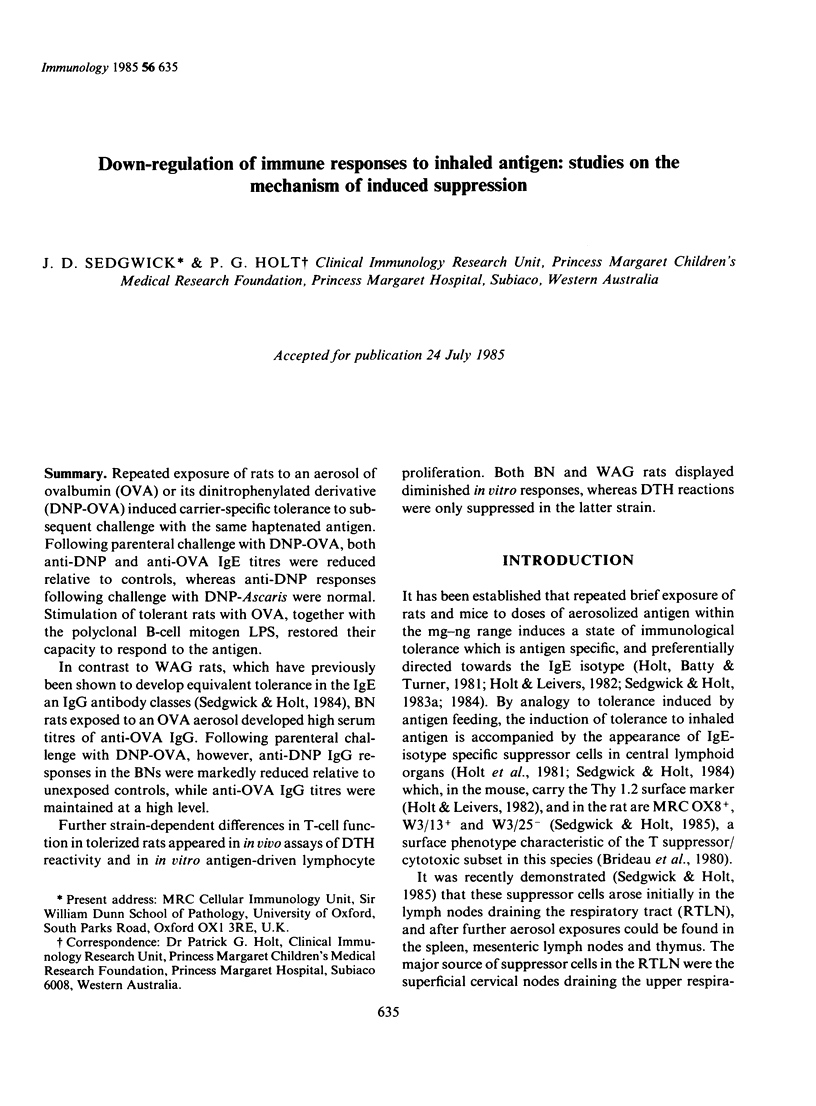
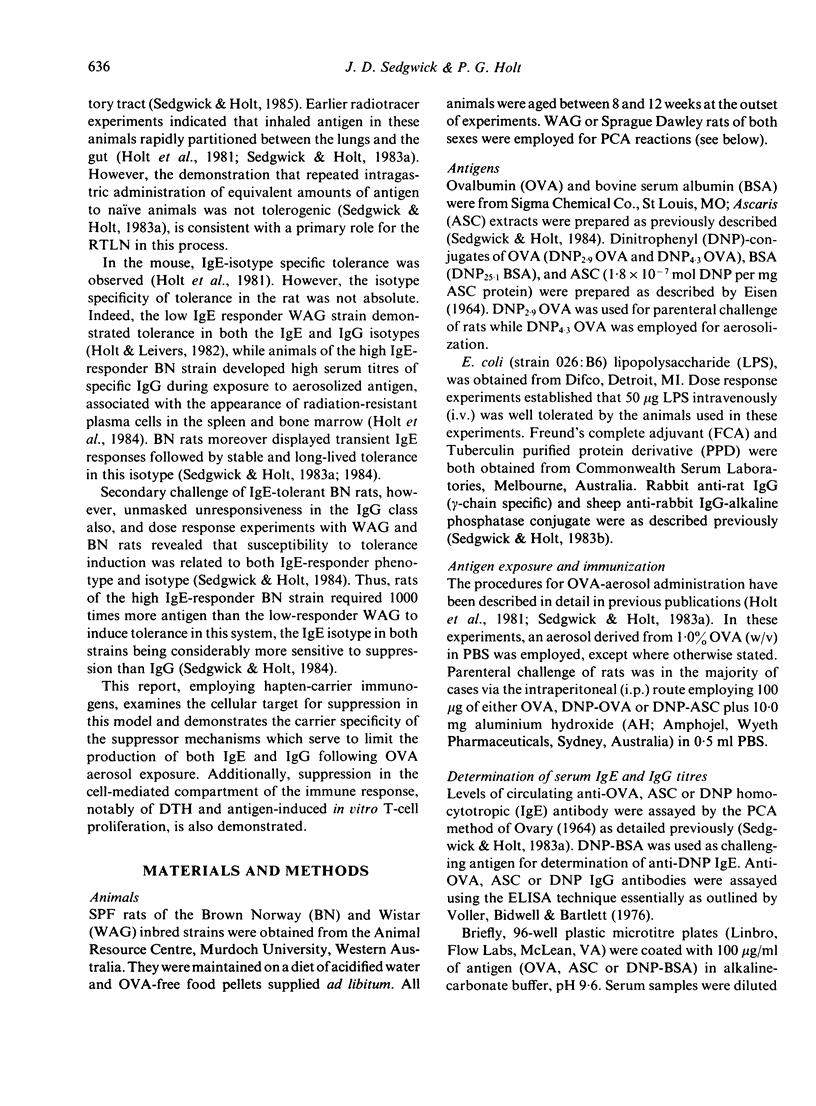
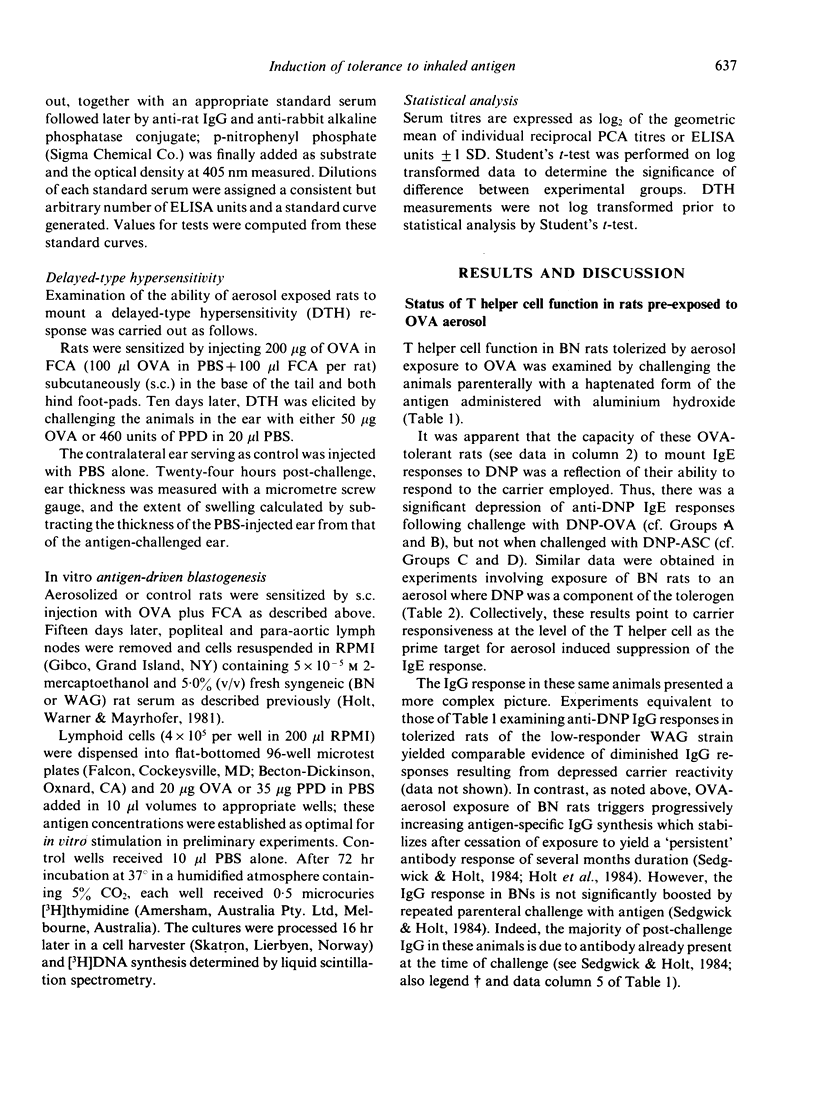
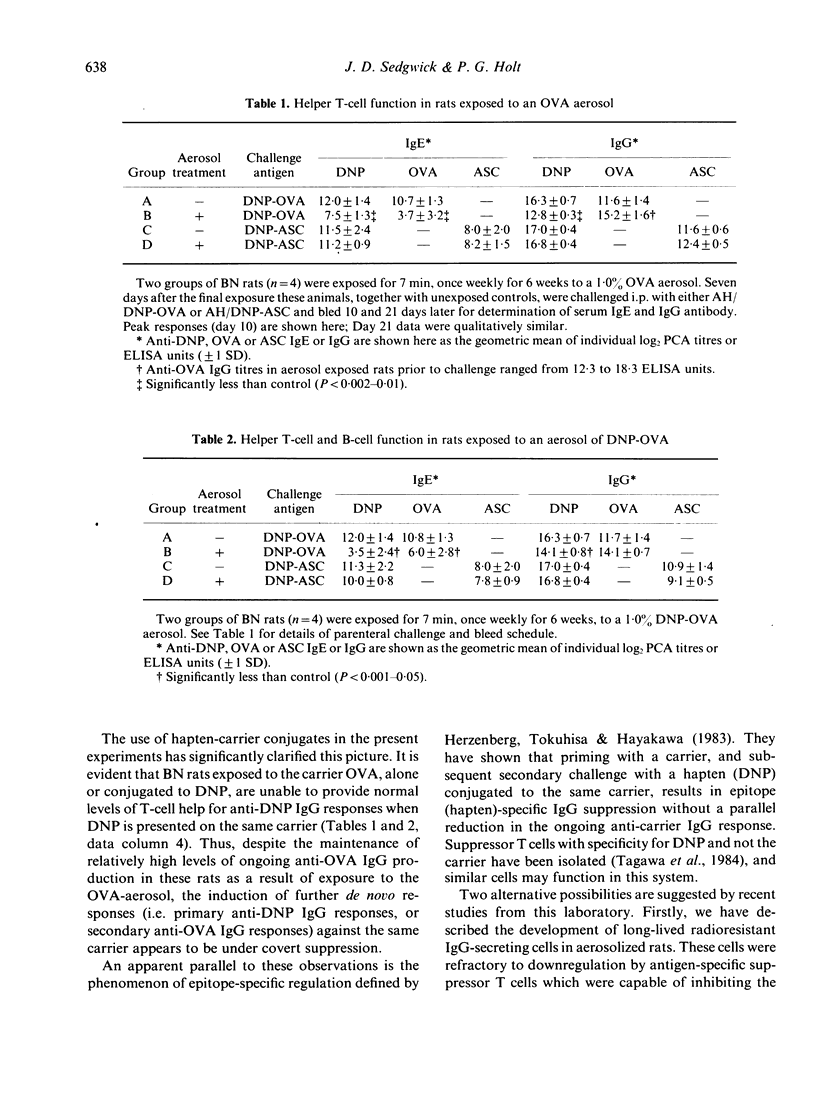
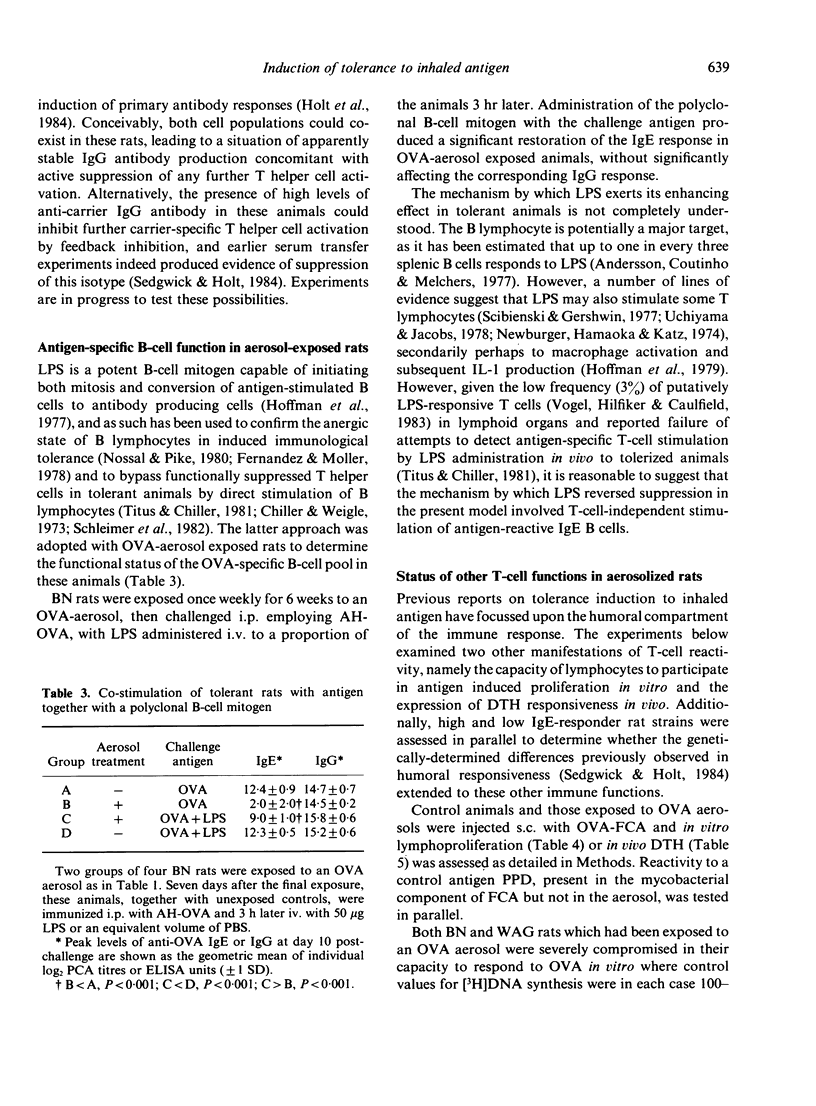
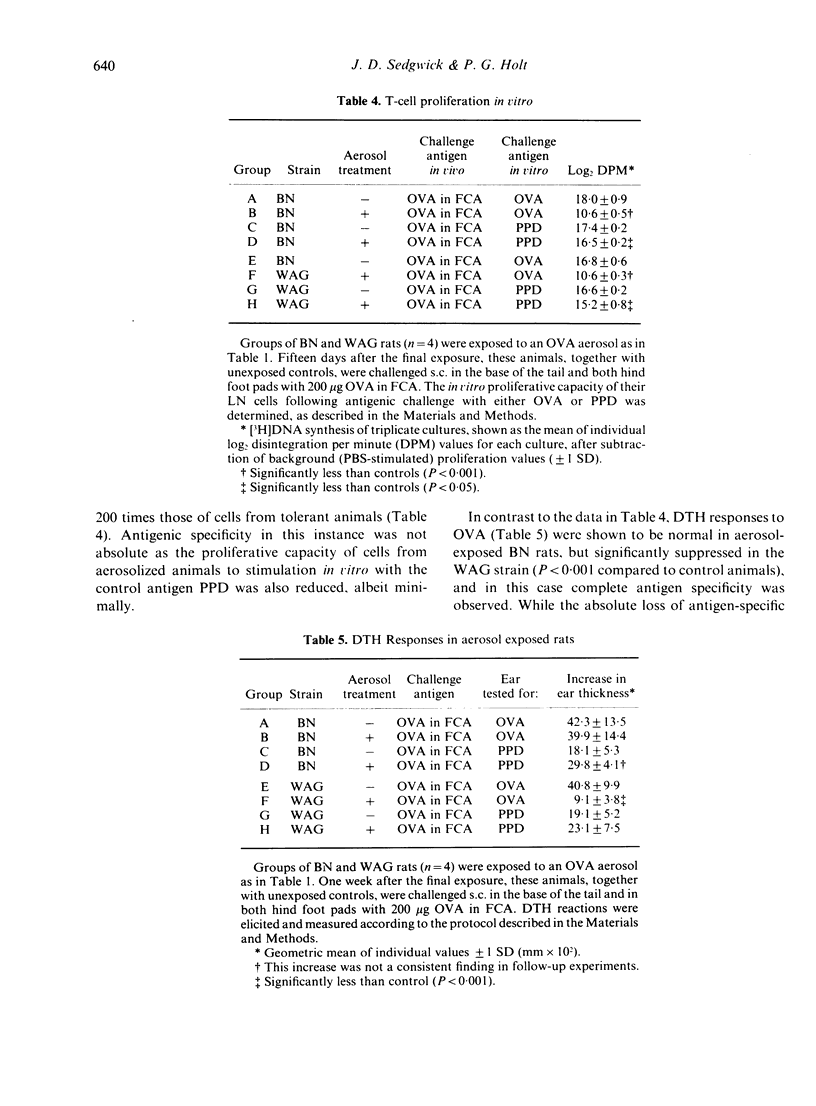
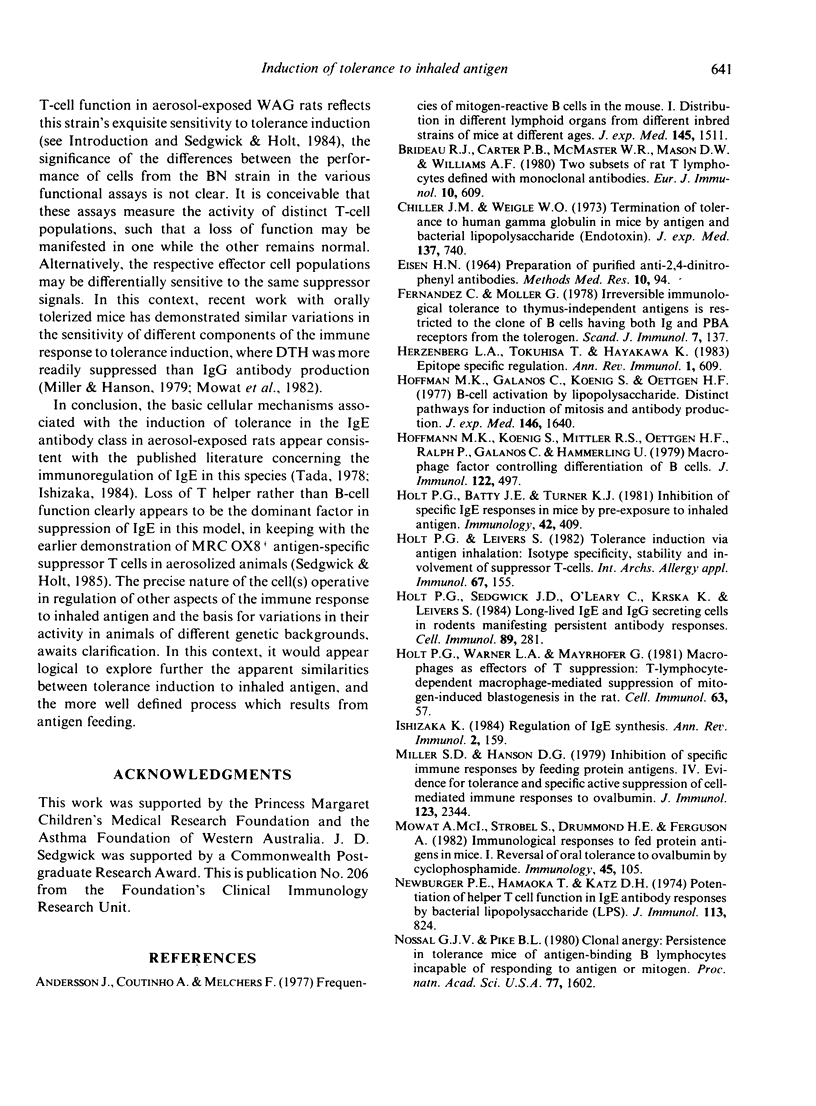
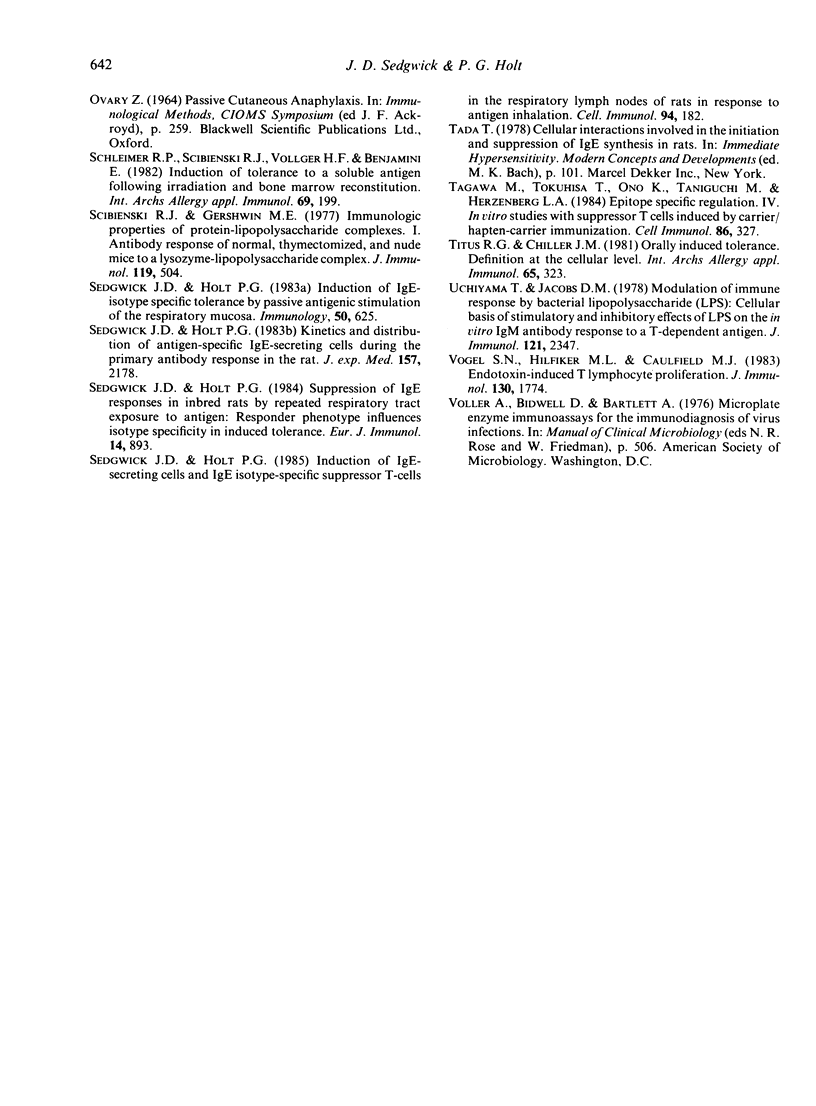
Selected References
These references are in PubMed. This may not be the complete list of references from this article.
- Andersson J., Coutinho A., Melchers F. Frequencies of mitogen-reactive B cells in the mouse. I. Distribution in different lymphoid organs from different inbred strains of mice at different ages. J Exp Med. 1977 Jun 1;145(6):1511–1519. doi: 10.1084/jem.145.6.1511. [DOI] [PMC free article] [PubMed] [Google Scholar]
- Brideau R. J., Carter P. B., McMaster W. R., Mason D. W., Williams A. F. Two subsets of rat T lymphocytes defined with monoclonal antibodies. Eur J Immunol. 1980 Aug;10(8):609–615. doi: 10.1002/eji.1830100807. [DOI] [PubMed] [Google Scholar]
- Chiller J. M., Weigle W. O. Termination of tolerance to human gamma globulin in mice by antigen and bacterial lipopolysaccharide (endotoxin). J Exp Med. 1973 Mar 1;137(3):740–750. doi: 10.1084/jem.137.3.740. [DOI] [PMC free article] [PubMed] [Google Scholar]
- EISEN H. N. PREPARATION OF PURIFIED ANTI-2,4-DINITROPHENYL ANTIBODIES. Methods Med Res. 1964;10:94–102. [PubMed] [Google Scholar]
- Fernandez C., Möller G. Irreversible immunological tolerance to thymus-independent antigens is restricted to the clone of B cells having both Ig and PBA receptors for the tolerogen. Scand J Immunol. 1978;7(2):137–144. doi: 10.1111/j.1365-3083.1978.tb00436.x. [DOI] [PubMed] [Google Scholar]
- Herzenberg L. A., Tokuhisa T., Hayakawa K. Epitope-specific regulation. Annu Rev Immunol. 1983;1:609–632. doi: 10.1146/annurev.iy.01.040183.003141. [DOI] [PubMed] [Google Scholar]
- Hoffmann M. K., Galanos C., Koenig S., Oettgen H. F. B-cell activation by lipopolysaccharide. Distinct pathways for induction of mitosis and antibody production. J Exp Med. 1977 Dec 1;146(6):1640–1647. doi: 10.1084/jem.146.6.1640. [DOI] [PMC free article] [PubMed] [Google Scholar]
- Hoffmann M. K., Koenig S., Mittler R. S., Oettgen H. F., Ralph P., Galanos C., Hammerling U. Macrophage factor controlling differentiation of B cells. J Immunol. 1979 Feb;122(2):497–502. [PubMed] [Google Scholar]
- Holt P. G., Batty J. E., Turner K. J. Inhibition of specific IgE responses in mice by pre-exposure to inhaled antigen. Immunology. 1981 Mar;42(3):409–417. [PMC free article] [PubMed] [Google Scholar]
- Holt P. G., Leivers S. Tolerance induction via antigen inhalation: isotype specificity, stability, and involvement of suppressor T cells. Int Arch Allergy Appl Immunol. 1982;67(2):155–160. doi: 10.1159/000233007. [DOI] [PubMed] [Google Scholar]
- Holt P. G., Sedgwick J. D., O'Leary C., Krska K., Leivers S. Long-lived IgE- and IgG-secreting cells in rodents manifesting persistent antibody responses. Cell Immunol. 1984 Dec;89(2):281–289. doi: 10.1016/0008-8749(84)90330-7. [DOI] [PubMed] [Google Scholar]
- Holt P. G., Warner L. A., Mayrhofer G. Macrophages as effectors of T suppression: T-lymphocyte-dependent macrophage-mediated suppression of mitogen-induced blastogenesis in the rat. Cell Immunol. 1981 Sep 1;63(1):57–70. doi: 10.1016/0008-8749(81)90028-9. [DOI] [PubMed] [Google Scholar]
- Ishizaka K. Regulation of IgE synthesis. Annu Rev Immunol. 1984;2:159–182. doi: 10.1146/annurev.iy.02.040184.001111. [DOI] [PubMed] [Google Scholar]
- Miller S. D., Hanson D. G. Inhibition of specific immune responses by feeding protein antigens. IV. Evidence for tolerance and specific active suppression of cell-mediated immune responses to ovalbumin. J Immunol. 1979 Nov;123(5):2344–2350. [PubMed] [Google Scholar]
- Mowat A. M., Strobel S., Drummond H. E., Ferguson A. Immunological responses to fed protein antigens in mice. I. Reversal of oral tolerance to ovalbumin by cyclophosphamide. Immunology. 1982 Jan;45(1):105–113. [PMC free article] [PubMed] [Google Scholar]
- Newburger P. E., Hamaoka T., Katz D. H. Potentiation of helper T cell function in IgE antibody responses by bacterial lipolysaccharide (LPS). J Immunol. 1974 Sep;113(3):824–829. [PubMed] [Google Scholar]
- Nossal G. J., Pike B. L. Clonal anergy: persistence in tolerant mice of antigen-binding B lymphocytes incapable of responding to antigen or mitogen. Proc Natl Acad Sci U S A. 1980 Mar;77(3):1602–1606. doi: 10.1073/pnas.77.3.1602. [DOI] [PMC free article] [PubMed] [Google Scholar]
- Schleimer R. P., Scibienski R. J., Vollger H. F., Benjamini E. Induction of tolerance to a soluble antigen following irradiation and bone marrow reconstitution. Int Arch Allergy Appl Immunol. 1982;69(3):199–205. doi: 10.1159/000233213. [DOI] [PubMed] [Google Scholar]
- Scibienski R. J., Gershwin M. E. Immunologic properties of protein-lipopolysaccharide complexes. I. Antibody response of normal, thymectomized, and nude mice to a lysozyme-lipopolysaccharide complex. J Immunol. 1977 Aug;119(2):504–509. [PubMed] [Google Scholar]
- Sedgwick J. D., Holt P. G. Induction of IgE-isotype specific tolerance by passive antigenic stimulation of the respiratory mucosa. Immunology. 1983 Dec;50(4):625–630. [PMC free article] [PubMed] [Google Scholar]
- Sedgwick J. D., Holt P. G. Induction of IgE-secreting cells and IgE isotype-specific suppressor T cells in the respiratory lymph nodes of rats in response to antigen inhalation. Cell Immunol. 1985 Aug;94(1):182–194. doi: 10.1016/0008-8749(85)90095-4. [DOI] [PubMed] [Google Scholar]
- Sedgwick J. D., Holt P. G. Kinetics and distribution of antigen-specific IgE-secreting cells during the primary antibody response in the rat. J Exp Med. 1983 Jun 1;157(6):2178–2183. doi: 10.1084/jem.157.6.2178. [DOI] [PMC free article] [PubMed] [Google Scholar]
- Sedgwick J. D., Holt P. G. Suppression of IgE responses in inbred rats by repeated respiratory tract exposure to antigen: responder phenotype influences isotype specificity of induced tolerance. Eur J Immunol. 1984 Oct;14(10):893–897. doi: 10.1002/eji.1830141006. [DOI] [PubMed] [Google Scholar]
- Tagawa M., Tokuhisa T., Ono K., Taniguchi M., Herzenberg L. A., Herzenberg L. A. Epitope-specific regulation. IV. In vitro studies with suppressor T cells induced by carrier/hapten-carrier immunization. Cell Immunol. 1984 Jul;86(2):327–336. doi: 10.1016/0008-8749(84)90387-3. [DOI] [PubMed] [Google Scholar]
- Titus R. G., Chiller J. M. Orally induced tolerance. Definition at the cellular level. Int Arch Allergy Appl Immunol. 1981;65(3):323–338. [PubMed] [Google Scholar]
- Uchiyama T., Jacobs D. M. Modulation of immune response by bacterial lipopolysaccharide (LPS): cellular basis of stimulatory and inhibitory effects of LPS on the in vitro IgM antibody response to a T-dependent antigen. J Immunol. 1978 Dec;121(6):2347–2351. [PubMed] [Google Scholar]
- Vogel S. N., Hilfiker M. L., Caulfield M. J. Endotoxin-induced T lymphocyte proliferation. J Immunol. 1983 Apr;130(4):1774–1779. [PubMed] [Google Scholar]


